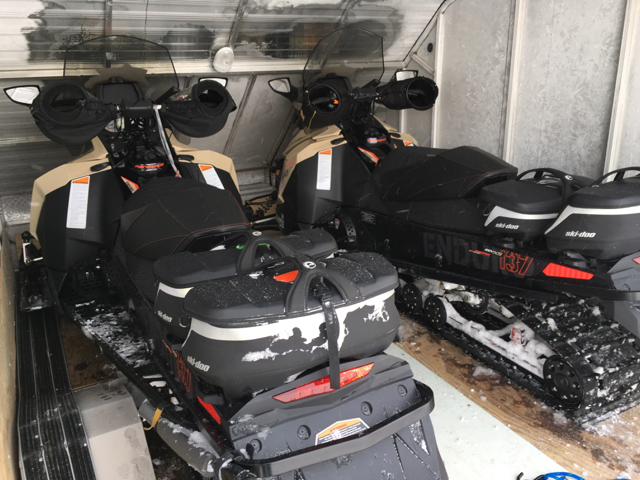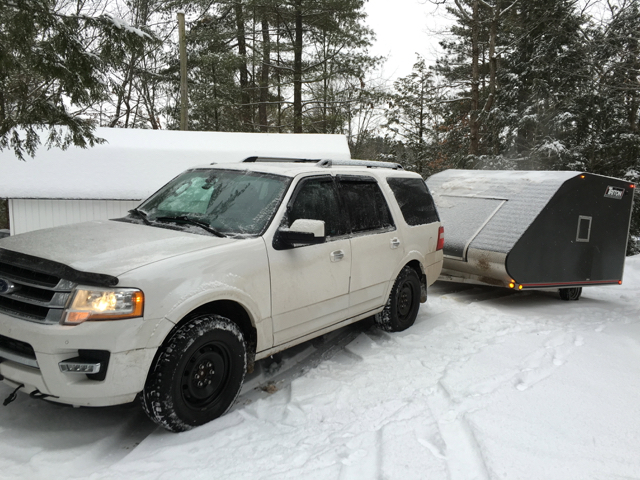Get Ready For Snowmobiling & Avoid Hassles…
Related: Choosing The Right Sled
I’m providing these prepping snowmobile tips and how-to snowmobile video. Why? Because everyone should be getting prepared to ride as the fall snowmobile magazines arrive or if snow conditions are ready early. Not scrambling at the last minute. This way, if you discover anything major that needs attention, you’ll have time to rectify it before the snow flies.
Novice rider should pay special attention to these tips and also look at my beginners tips. Remember, everything’s been sitting for many months. Many bad things can happen to idle snow machines and other equipment. Meanwhile, if you discover you need anything new, you can find it before stock sells out. Besides, spending your autumn getting ready to go snowmobiling is better than moping around. Yes, getting ready is the next best thing to actually doing it. So here let’s get started…
Prepping Snowmobile Tips For Trail Riders
#1 – Eyeball Your Snow Machine
Once snow conditions are good, you don’t want any down time caused by snowmobile problems. So eye-ball every wear part to confirm its good to go as is, make it good as new or replace it. An ongoing maintenance log helps keep me aware of what’s been done when and what’s up next. For those more mechanically inclined, check out more sled maintenance tips here. And remember, the best way to get ready starts with good summerizing.
#2 – Check Your Trailer
If you’re a trailer person, you want to ensure getting to your snowmobile tour destination every time, with your snowmobiles in one piece. That means checking all major components of your trailer early. This includes tires, bearings, hitch and chains, axle and springs, bed and cover, lights and electrical early. I’ve had excellent performance from my Triton trailer.
#3 – Service Your Vehicle
Unlike your sled and trailer, your tow vehicle has been used constantly since last winter. So you should do a complete winter service, including installing snow tires. Be sure to remind your mechanic that you’ll doing more winter driving than most people. Plus a lot of towing in all kinds of snow conditions. So pay special attention to all tow package components. Also pack your winter emergency kit.
#4 – Inspect Your Gear
Make sure everything is fitting and functioning properly. I inspect all fasteners. This includes straps, seams and making certain that everything still fits my body and sled (especially important if you’ve changed sleds since last winter). This way, you also know if anything is missing from your riding inventory and needs to be replaced.
#5 – Ready Your Itinerary
It’s always fun to start planning where you’re going to ride. Early prep allows you to compare destinations and routes, schedule dates and confirm companions. Plus have back ups plans ready, just in case snow conditions change. Early planning also enables you to provide priority notice of being away to family and business associates. And yes, taking care of business during the fall is your best guarantee of being able to ride uninterrupted all winter!
#6 – Plan Your Ride
Once winter arrives, whether you’re leaving for a day trip or an extended saddlebag tour, do the same planning and preparation. The fact is that your snow machine can transport you far from home, roads or population. So you’re effectively on your own if anything goes wrong, regardless of how long a trip you’re on. So for snowmobile safety, always leave prepared…
#7 – Pay Attention To Your Sled
Pay attention to your snow machine, because you need it to get back. Do a once-over inspection prior to each trip, before leaving home. Carry spare plugs, belt, gas line anti-freeze and a basic tool kit This includes duct tape, plastic ties and wire. And don’t set out without full gas and oil tanks — and knowing where your next fill-up is.
#8 – Before Leaving
Make note of your departure time, route, expected lunch stop and return time. Update it from the trail if changes occur. Make sure your cell phone has a full battery charge. If you have electric start and a 12-volt outlet, carry a cord to plug into your sled. If there’s someone at home (or an answering machine), check in at lunch and again at your last pit stop before returning.
It’s also a smart idea to give everyone in your group a “lifeline” number to call if you become separated. That way, even if they can’t get in touch with you, a third party will know where everyone is. Make certain all riders have a map, compass and that there’s at least one GPS. Always carry a basic survival/first aid kit and a stout piece of rope at least 20 feet/6.1 m long.
# 9 – Prep For Bad Ride
Next, prepare yourself for a ride that could go wrong. If you always wear water and wind proof outerwear, you’ll never get caught short if the weather suddenly changes. Dress for the coldest part of the day. Be prepared to take off/put on layer(s) as needed.
I suggest riding with a bag that has room for that extra fleece or jacket liner. I also have a handle bar bag, which contains work gloves, a bottle of water, sunglasses and a roll of toilet paper, among other essentials. On my person, I carry a pocketful of chemical hand warmers, fire starter materials, plus a granola bar or two, lip balm, Tylenol and antacid tablets.
#10 – Prepping Snowmobile Tips Classic Video
Get ready with this classic Snowmobiler Television video clip from The Intrepid Snowmobiler.
You can’t anticipate everything, but if you cover off the items on my prepping snowmobile tips checklist, your odds of having a trouble-free season will be mighty good. Now just pray for great snow conditions!
Like This Post? Follow Me on Facebook!
The tips and advice in this blog are the opinions of the author, may not work in every situation and are intended only for the convenience and interest of the reader, who has the personal responsibility to confirm the validity, accuracy and relevancy of this information prior to putting it to their own use.




